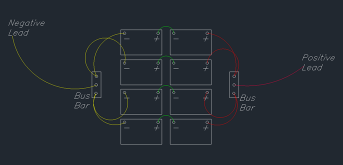I have a current setup in an electric car of 7 U27-12XP is serie, managed by an U-BMS LV. I have 2 cars but some batteries are sho, at least one with a 0V cell and the 6 others were exhibiting a low voltage of 2,8V (battery, not cell). Even if the took a charge, I'm short of one battery to test further.
I'm waiting for a second car to arrive, with maybe more luck with batteries...
In any case, even if I can salvage one full working set of batteries, I will be short for the second car.
Finding second hand batteries in France seems difficult, and considering the very low voltage of the 6 other, I'm afraid they will not last very long.
I'm considering keeping Valence technology (U-BMS + each battery BMS) but to use instead 280 Ah LFP cells, connected in series (28). I have just enough room in the battery compartment for such installation.
The choice to keep Valence system is due to the CANBUS connection of car charger, speed controller and VMU...
I'm questionning myself if the U-BMS may raise an error if suddenly all batteries increased from 138 Ah to 280Ah... Is the U-BMS only managing throught he voltage of each cell or is it also counting the in and out Ah through the internal shunt of each battery?
What are your thought on this "upgrade"?
Other option is to stick with near 138 Ah cells, so 152 are the best candidates...but if I can increase almost by 2 the range of the car, I would take it! It would also limit cells aging bi dividing C discharge by 2...
Thanks in advance for your inputs!
I'm waiting for a second car to arrive, with maybe more luck with batteries...
In any case, even if I can salvage one full working set of batteries, I will be short for the second car.
Finding second hand batteries in France seems difficult, and considering the very low voltage of the 6 other, I'm afraid they will not last very long.
I'm considering keeping Valence technology (U-BMS + each battery BMS) but to use instead 280 Ah LFP cells, connected in series (28). I have just enough room in the battery compartment for such installation.
The choice to keep Valence system is due to the CANBUS connection of car charger, speed controller and VMU...
I'm questionning myself if the U-BMS may raise an error if suddenly all batteries increased from 138 Ah to 280Ah... Is the U-BMS only managing throught he voltage of each cell or is it also counting the in and out Ah through the internal shunt of each battery?
What are your thought on this "upgrade"?
Other option is to stick with near 138 Ah cells, so 152 are the best candidates...but if I can increase almost by 2 the range of the car, I would take it! It would also limit cells aging bi dividing C discharge by 2...
Thanks in advance for your inputs!






